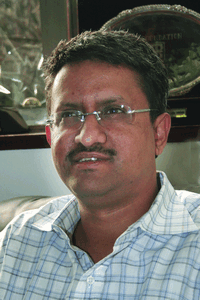India's domestic market may be growing at double-digit rates but profits continue to elude the country's carriers
All five of India's domestic low-cost carriers continue to incur huge losses and with fuel prices at all-time highs it is unlikely there will be any relief any time soon.
The low-cost operators - Deccan, Indigo, SpiceJet, Jetlite and GoAir - now control almost half of the market and this year are projected to carry more than 20 million passengers. But all five have been unprofitable since their respective launches and losses continue to pile up despite efforts to stop the bleeding.
Airline executives complain that until the two main barriers to profitability in India - airport infrastructure and fuel taxes - are eased it will simply be impossible to make money despite strong demand. "The issues of Indian aviation continue to be the tax on fuel and the infrastructure, which makes it a difficult environment to operate," says Deccan chief executive Ramki Sundaram.
Deccan has incurred losses of about $300 million over the last two years, including a $50 million loss for the quarter ending 31 March, only a 6% improvement over the previous year. Sundaram says efforts over the last year to restructure the carrier's network and improve its yield have been offset by soaring fuel costs.
Concerns about the sector are also being expressed by the civil aviation ministry, which until recently had been consistently upbeat. Minister Praful Patel said at a meeting in early May of the parliamentary consultative committee on civil aviation that he had "mixed feelings" about the domestic market, which grew 11% in terms of domestic passenger numbers in the first quarter to 11.2 million. "There are now better fares, more choice and more connectivity for the people," the ministry said in a statement after the meeting, but the impact of high fuel prices and taxes "was a reason for worry".
 |
|---|
"As oil prices rise, the states are making even more for their coffers"Ramki Sundaram |
GoAir chief executive Edgardo Badiali says nearly 50% of GoAir's costs are now fuel because fuel taxes, which in India are set and levied individually by each state, average about 30%. He says when including the tax, the price of fuel in India is 70% more than in Europe and this makes it impossible for any Indian low-cost carrier to be profitable. "Nobody is profitable [but] if the fuel costs were the same as Europe no one would be crying," he says.
Adds Sundaram: "The increase in oil prices in the last six to nine months has made the duty even tougher. Penny for penny as oil prices increase, the states are making even more for their coffers."
But Sundaram and Badiali are quick to point out that a couple of India's states earlier this year cut their fuel tax to 4% and the pressure is mounting for more to follow suit. "A few states have brought this to 4% which is a healthy change," Sundaram says. "What it shows is some states are cognisant that a healthy airline business is important to the economy of states and their residents. It's in the interest of the industry to have lower tax rates because in this high oil price environment it will help increase traffic and help the economy."
Airport infrastructure, which prevents carriers from adding capacity in key markets such as Mumbai, is another big barrier to profitability in the Indian low-cost sector. "There is no place to profitably place additional aircraft," Badiali says, adding at the last slot conference in Mumbai not a single new slot was made available. "At the moment there are a lot of bottlenecks. Some will be there for one more year, some for three to four."
Sundaram says while several airport expansion projects are now underway "it will take time for airports, especially Mumbai and Delhi, to sort themselves".
The good news for low-cost carriers is that while competition remains fierce Sundaram says consolidation in the market has "brought down the competition intensity". The market is now led by three new combinations - Air India and Indian Airlines, including low-cost unit Air India Express, which primarily operates international services Jet Airways and Air Sahara, now known as Jetlite and Kingfisher Airlines and Deccan. Jet remains the market leader among full-service carriers, capturing a 22.7% share of the domestic market in the first quarter, followed by Air India with 14.7% and Kingfisher with 14.5.%
Sundaram expects the Deccan-Kingfisher, Air India-Indian and Jet-Jetlite groups to secure 70% to 80% of the domestic market going forward. Badiali says there is still more than enough demand to support three independent low-cost carriers - GoAir, Indigo and SpiceJet - and several regional and cargo players.
"If you listen to rumours in the market there will be more consolidation but personally I think it will stay more or less like this," Badiali says. "These six players are in quite a good position. If you are one of the six you are in good position if the market opens up and infrastructure expands, if all the bottlenecks come down over the next year or two."
Tony Fernandes, the head of Malaysian-based AirAsia, which plans to start flights to India in October, says profitability in the Indian low-cost sector "will happen without a doubt". But he adds that so far airlines are not following the right model and are competing too much on the same routes and at the same airports. "I don't think it's a cost problem," he says. "I think they are not following the model. We'll let all the Indian airlines kill each other first. Then we will come in."
For more on Deccan and Go Air, read our recent web chief executive interviews: flightglobal.com/badiali and: flightglobal.com/deccan
Source: Airline Business



















